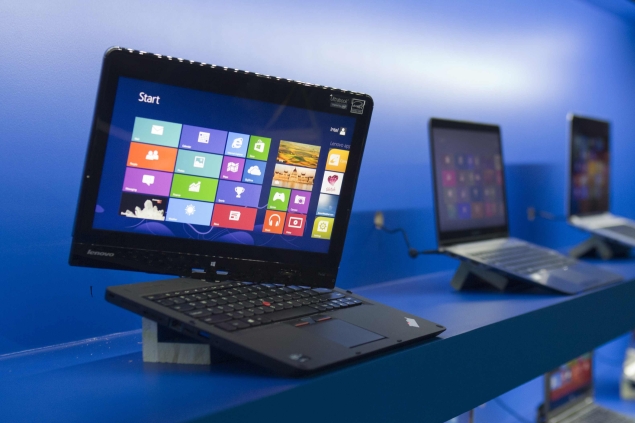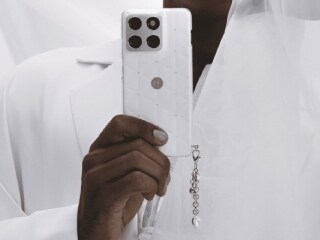- Home
- Laptops
- Laptops Features
- Beyond ultrabooks: Looking for the next big form factor in computing
Beyond ultrabooks: Looking for the next big form factor in computing

Both personal computers and mobile devices have gone through tremendous change in the last five years, in terms of how powerful they are, what they can be used for, and even something as simple as what they look like. With power starting to plateau, design is quickly emerging as one of the key differentiators for brands and today what your phone or laptop looks like is as important a consideration as any other.
Debjani Ghosh, Managing Director, Sales and Marketing Group at Intel South Asia says, "Today the technology industry is accelerating at a pace like never before and computing is becoming more personal. This year we'll see a truly revolutionized personal computing scenario with myriad form factors right from the traditional clamshell laptops, ultrabooks, tablets to newer form factors like the 2 in 1s, All in One PCs, and the Next Unit of Computing."
But the big changes aren't just in the form factors, but also in the underlying technology. Ghosh says, "We'll see devices becoming more intuitive making it easier for consumers to use their devices productively. The advent of wearables will further the connected device phenomenon making the Internet of Things more than just a buzz word in the industry because we not only will we see multiple devices getting connected and talking to each other on end, but on the other we'll see the sense of Big Data evolving as a result of these connected devices. At Intel we're very excited with all the possibilities that lie ahead of us and we're looking forward to driving this transformation with the range of innovative products and technologies in our fold."
Beyond the ultrabook
With laptops, one of the last big changes was when Intel created the ultrabook category in 2012. Ultrabooks were not very different from the other laptops in the market - but they certainly looked different. The super slim designs that Intel's strict size specifications led to often resembled the Macbook Air. The ultrabooks were pretty expensive though, and met a limited market, but had an indirect impact on the larger trends in the development of laptops.
Sandeep Aurora, Director Marketing and Market Development at Intel India says, "The ultrabook was a success because even though not everyone bought an ultrabook, today you'll see that most laptops are thinner and lighter than before. It took a lot of work behind the scenes, working with people on the display side and the battery side, to make ultrabooks possible, but then this would eventually benefit all laptops."
Today, the trend is towards the 2-in-1 - these hybrid convertibles were launched by companies like Dell, HP and Asus in the wake of the growing popularity of tablets. Some, like the Lenovo Yoga, can flip 360 degrees to function as a tablet. Others like the Acer W510 let you detach the monitor from the keyboard, to use it as a tablet. The keyboard adds battery life, ports and of course, a keyboard and a mouse.
Aurora says, "The 2-in-1 serves a basic need, not everyone wants to buy a separate tablet and a laptop. For me at least, the iPad is for consumption - when I'm typing I don't want to tilt my head down to see the screen at all times." He added that he wasn't ruling out tablets as a means of content creation, particularly in light of the launch of MS Office for the iPad, but says, "we want to give customers choices. All the options will exist side by side."
For Aurora personally, the design of choice is the detachable keyboard style of 2-in-1 but he says that the various hardware partners Intel works with claim that all the different designs are working well in the market. What's coming next from Intel is building on the 2-in-1, much as these hybrids themselves are an extension of the idea of the ultrabook.
"We have to answer a lot of questions about these devices - how do they process in tablet mode, what is the battery mechanism, there's a lot of back end infrastructure that Intel has developed. What you're going to see now is more intelligent computing, as we move closer to an Internet of Things," Aurora says.
While the results are still years down the road, Intel is looking the benefits of gesture controls, eye tracking and voice controls. These technologies would find adoption beyond the laptop or the phone, making cars and televisions smarter too, a process that is just a few years away, according to Intel.
From mobiles to wearables
Meanwhile, Qualcomm has been making steady strides in changing the face of mobile phones, and today sees us at the cusp of a wearable revolution. Michelle Leyden-Li, Senior Director of Marketing, Qualcomm, outlined some of the work that the company is doing in the wearable space.
Li says, "Qualcomm's inventions span many technologies that can be leveraged in the wearable segment. These include wireless connectivity, low power computing and displays, a broad range of support for sensor technologies, AllJoyn software framework, Gimbal context aware framework, Qualcomm IZat position location, and WiPower wireless power solution."
Qualcomm is also responsible for Mirasol display, which hasn't seen very widespread adoption yet, but was prominently showcased in the Toq smartwatch in September.
Li explains, "We believe connectivity is a key component to the future of new mobile device categories like wearables and have a portfolio of products to enable this whether through 4G, 3G, Bluetooth or Wi-Fi. Our innovative Mirasol display technology used in our Toq smartwatch, provided an ability to acquire key early learnings in this new device category as we further engage with customers and enhance our product and technology roadmap for this emerging device segment."
The company is also working with Google on their newly announced Android Wear platform.
Li further adds, "The Qualcomm Toq was a great step for us and a reference design for the industry. We see wearables as a very interesting opportunity and when we look at our own portfolio of products, we have all the pieces to go into that market."
But with so many of the components being standardised by a single source, much like in the PC market, there's a worry that sameness will set in. However, like in the phone market, Li feels that there are still enough options available to Qualcomm's hardware partners to bring in differentiation.
There are certain facets that all device makers have to consider, such as battery life, heat management, and also balancing the load on the cores of the chip. Qualcomm, Li explains, balances this across the entire system-on-a-chip, and this is true for phones, tablets and wearables - though wearables will be "even smaller, have different performance needs and be lighter and thinner."
To avoid homogenisation in the market, Qualcomm works with its partners and tailors their SoC to the needs of the device makers. Li says, "There are unique priorities that depend on the partners' needs. So we work very closely with the customer to understand what impacts their design criteria and the types of differentiation that they want to deliver to consumers; so that we can make sure that whatever we are doing at the SoC and chipset level is in line with what our customers need."
At the 2014 Mobile World Congress, Broadcom also made announcements which could have an impact on the future development of wearables. For instance, the company announced a new NFC implementation which would be 35% cheaper to use, and would consume 60% less energy. They also showed a new location tracking module which is designed for high accuracy and low power consumption, which could be useful in fitness trackers.
What's next?
The first wave of smartwatches that we're expecting soon is just that - the first wave. People in the industry are more excited than ever about the Internet of Things - and smartphones paved the way for this eventuality. Rajiv Kapur, managing director of Broadcom India, says that the development of underlying technology like battery life and the continuing evolution of protocols like Bluetooth and NFC will make it easier for anyone to make wearables, and not just the established companies.
Pointing to devices like the Pebble smartwatch, Kapur says, "The barrier to entry is now very low, and this is going to bring about some interesting developments. It's a wide open field, and in the US, someone who is making a wearable is going to make a 'cool gadget'. But someone in India might be identifying a need gap in the market here, to make a wearable that looks at things like child safety, or women's safety, or heat management. Wearables and the Internet of things can bring about a completely different breed of solutions."
Whether you're looking at something like the MetaWear, or Intel's Next Unit of Computing, we're opening up to a world where cheap tinkering is easier than ever, and new designs and new products are the natural outcome.
Get your daily dose of tech news, reviews, and insights, in under 80 characters on Gadgets 360 Turbo. Connect with fellow tech lovers on our Forum. Follow us on X, Facebook, WhatsApp, Threads and Google News for instant updates. Catch all the action on our YouTube channel.
Related Stories
- Samsung Galaxy Unpacked 2025
- ChatGPT
- Redmi Note 14 Pro+
- iPhone 16
- Apple Vision Pro
- Oneplus 12
- OnePlus Nord CE 3 Lite 5G
- iPhone 13
- Xiaomi 14 Pro
- Oppo Find N3
- Tecno Spark Go (2023)
- Realme V30
- Best Phones Under 25000
- Samsung Galaxy S24 Series
- Cryptocurrency
- iQoo 12
- Samsung Galaxy S24 Ultra
- Giottus
- Samsung Galaxy Z Flip 5
- Apple 'Scary Fast'
- Housefull 5
- GoPro Hero 12 Black Review
- Invincible Season 2
- JioGlass
- HD Ready TV
- Laptop Under 50000
- Smartwatch Under 10000
- Latest Mobile Phones
- Compare Phones
- Realme P4x 5G
- OnePlus Ace 6T
- OPPO A6x 5G
- Samsung Galaxy Z TriFold
- Poco F8 Ultra
- Poco F8 Pro
- Huawei Mate 80 RS Master Edition
- Huawei Mate 80 Pro Max
- Asus ProArt P16
- MacBook Pro 14-inch (M5, 2025)
- Poco Pad M1
- Poco Pad X1
- Just Corseca Skywatch Pro
- Honor Watch X5
- Acerpure Nitro Z Series 100-inch QLED TV
- Samsung 43 Inch LED Ultra HD (4K) Smart TV (UA43UE81AFULXL)
- Asus ROG Ally
- Nintendo Switch Lite
- Haier 1.6 Ton 5 Star Inverter Split AC (HSU19G-MZAID5BN-INV)
- Haier 1.6 Ton 5 Star Inverter Split AC (HSU19G-MZAIM5BN-INV)

















